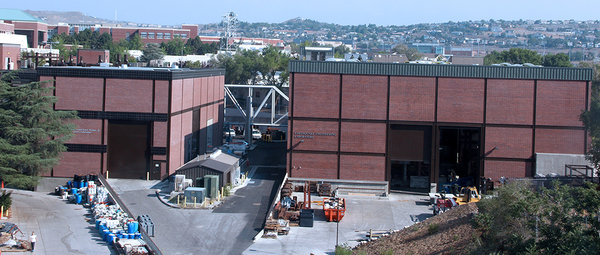The seismic safety of nuclear facilities and systems will be examined in a new multi-year, multi-million dollar, federally funded project to study the influence of soil on building behavior during earthquakes. The University of Nevada, Reno's world-renowned structural engineering laboratories are at the center of the project that will first construct one of the world's largest soil box/shake table systems, and then use it to investigate soil-structure interaction at a scale not previously possible.
"This grant will allow us to build a new, even larger, shake table than the ones we have in our earthquake engineering lab, as well as one of the world's largest soil boxes," Manos Maragakis, dean of the College of Engineering, said. "This will be a huge box, holding about 500 tons of soil. It will be unique in the world at this scale. Results from smaller boxes don't translate into the real world as well as experiments at the scale we will be using."
The new shake table and massive soil box will be located in the Rogers-Weiner Large-Scale Structures Laboratory. This high-bay lab, with its 35-foot-high ceiling, will accommodate the 25- by 25-foot table and box, which will have an approximate height of 20 feet. Large hydraulic actuators, or rams, will shake the soil in simulated earthquake ground motions of various levels of intensity.
The first two years of the five-year project will be building the new shake table and soil box.
"We'll be designing and building the new table and soil box in-house," Ian Buckle, civil engineering professor and lab director, said. "There are a number of options on size and capabilities that we'll explore based on our experience with building and operating servo-controlled hydraulic systems over the last two decades. We have some of the best engineers and technicians in the world working in the lab, but will probably need to increase the size of our group to keep pace with the demand."
The University's civil and environmental engineering department will receive $4.8 million for the design and construction of the soil box and its shake table. This will be followed by a three-year experimental program to study soil-structure interaction and validate numerical computer codes for predicting the interaction between large buildings and their underlying soils. These codes are being developed by researchers at the University of California, Davis, who are collaborators in this project.
The U.S. Department of Energy grant is administered through the agency's Lawrence Berkeley National Laboratory in Berkeley, California. The overall objective of this collaborative multi-year project, "Seismic Safety of Nuclear Facilities," is to develop advanced computational tools for modeling and simulating the earthquake response of nuclear facilities, including the effects of soil-structure-interaction.
The current method for evaluating this interaction is with computer and numerical modeling. This project will provide demonstrable data on how a massive structure such as a nuclear reactor will react with various soil types in an earthquake.
The University's new Earthquake Engineering Laboratory combined with the Large-Scale Structures Laboratory comprise the biggest, most versatile large-scale structures, earthquake/seismic engineering facility in the United States, according to National Institute of Standards and Technology, and possibly the largest University-based facility of its kind in the world. The addition of the fifth shake table will make the University of Nevada, Reno's earthquake engineering facility the most advanced of its kind in the world, with the largest collection of high performance shake tables than any other laboratory.
"The expansion of our large-scale structures earthquake engineering facility, with 44,000 square feet completed last year, allows us to use the original lab space to conduct these experiments with a new table and equipment," Maragakis said. "It's a huge return on investment, with our $3 million cost-sharing in the $23 million expansion, including a $12 million highly competitive federal grant. This will move us into the No. 1 spot in the world for this type of engineering experimentation."
"Federal grants such as this allow us to stay at the forefront of technological advancements and provide important information to the engineering industry, government agencies and others to build more seismically resilient structures," Marc Johnson, University president, said. "This further builds our reputation as a world leader in large-scale structure seismic experimentation."
Key members of the project team include team leader David McCallen of the Berkeley Lab, Boris Jeremic of U.C. Davis and the Berkeley Lab, who will serve as principal investigator for code development, and Buckle who will serve as principal investigator for the scaled experiments on soil-structure interaction.











